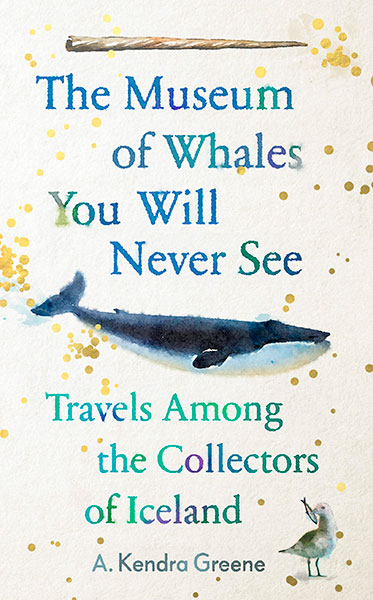The Museum of Whales You Will Never See: Travels Among the Collections of Iceland
A. Kendra Greene
(Granta Books, 2020); hbk, £14.99
A. Kendra Greene is no stranger to museums. As an artist and essayist who has spent most of her career dedicated to museums, she exhibits her own work in museums, and has managed many collections in the Museum of Contemporary Photography, the Chicago History Museum, and the University of Iowa Museum of Natural History. She has worked herself into them and around them. This collection of essays takes Greene far from the United States, searching the curiosities of Iceland’s isolated museums. Set out as a museum tour, Greene takes the reader to six unique ‘galleries’ across the country, and each gallery chapter is followed by an essay, or ‘cabinet’: an observation on her experience captured on the page for all to see. Some museums connote boredom and echoey rooms, but Greene’s prose is far from dusty, keeping a conversational tone and dropping humorous quips to keep the reader entertained. At the Phallalogical Museum we are told ‘Photography is permitted in the museum. Visitors may flash all they like.’
The museums vary widely in subject matter, from ornithology to the phalluses of all species, shapes and sizes, to testimonials of monster sightings. Diving into the heart of a culture that brings about these exhibits requires context; language, measurements and seasons are all explained as a point of reference in the beginning, later stopping me from skipping over unfamiliar letters in names. This is good, because it is to these names that Greene attaches much importance. This book is a tale about the people, not just the museums themselves. These museums are not odd, they are ordinary museums which contain oddities. Each museum has an origin story intrinsically tied to a person or people, whether a loved one who never saw its creation, or a collective of enthusiasts battling years of bureaucracy. These stories are what makes the museums unique, worth writing about.
Trying to identify that special ingredient that makes these museums museums, the book tries to untangle the abstract question of “what is a museum?”. The initial thought that it is a ‘loci of scholarship and preservation, a matter of caring for the public trust and refreshing exhibitions’ almost immediately conflicts with the premise of most of the museums visited in the book. Greene believes:
We can pinpoint the way a collection starts, the fact of the first thing, but a museum often enough has no one root. It is less discrete than continuous, less particle than wave. Its beginning is always hazy—no one thing, really, unless that one thing is something amorphous, something not really suited to words, something maybe spoken of best as something like want.
Greene attempts to understand this ‘want’ by discussing abstract ideas within the concrete reality of each museum’s display of objects, connecting the reader to actual senses. The emotional tie of wanting highlights that museums rely on the people who create them, but then, ‘When they become a cult of personality […] it sounds harsh to say it, but they’ve done something wrong.’ Such contradictions unfold in a book that explores uncertainty and curiosity. At once it acknowledges that these are museums because of people, while clashing against the academic definition of museums Greene has become accustomed to. This is precisely what make these essays a success; Greene is not afraid to admit uncertainty or demonstrate a change of mind. Rather than definitively answering theoretical questions, the book opens up possibilities for more. Perhaps the term ‘museum’ should be scrapped for these Icelandic collections, and ‘collective determinations’ be used instead, a phrase coined by Greene that perfectly describes the personal connections and ‘want’ that sparks the collections. In the end the ambiguity created makes the book itself a museum of sorts; exhibiting these museums’ stories.
Thomasin Collins


Leave a Reply